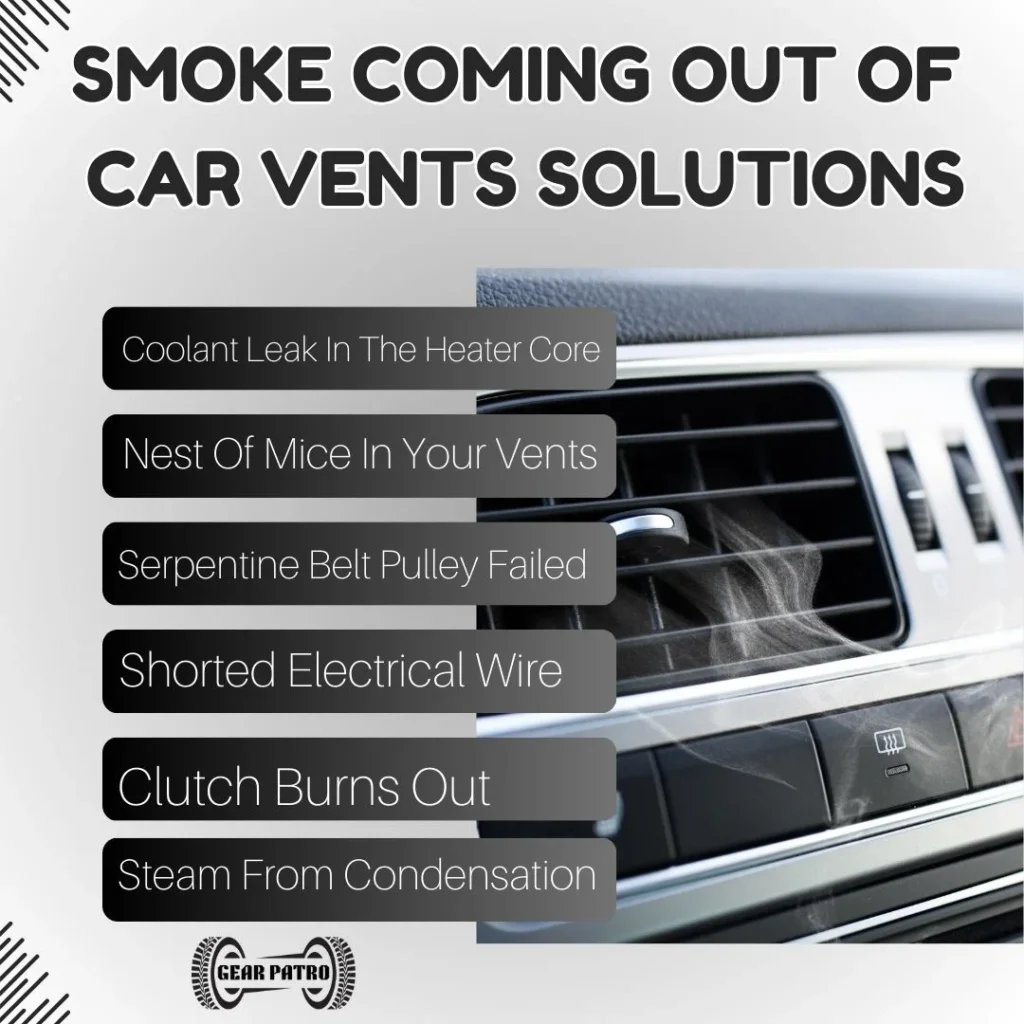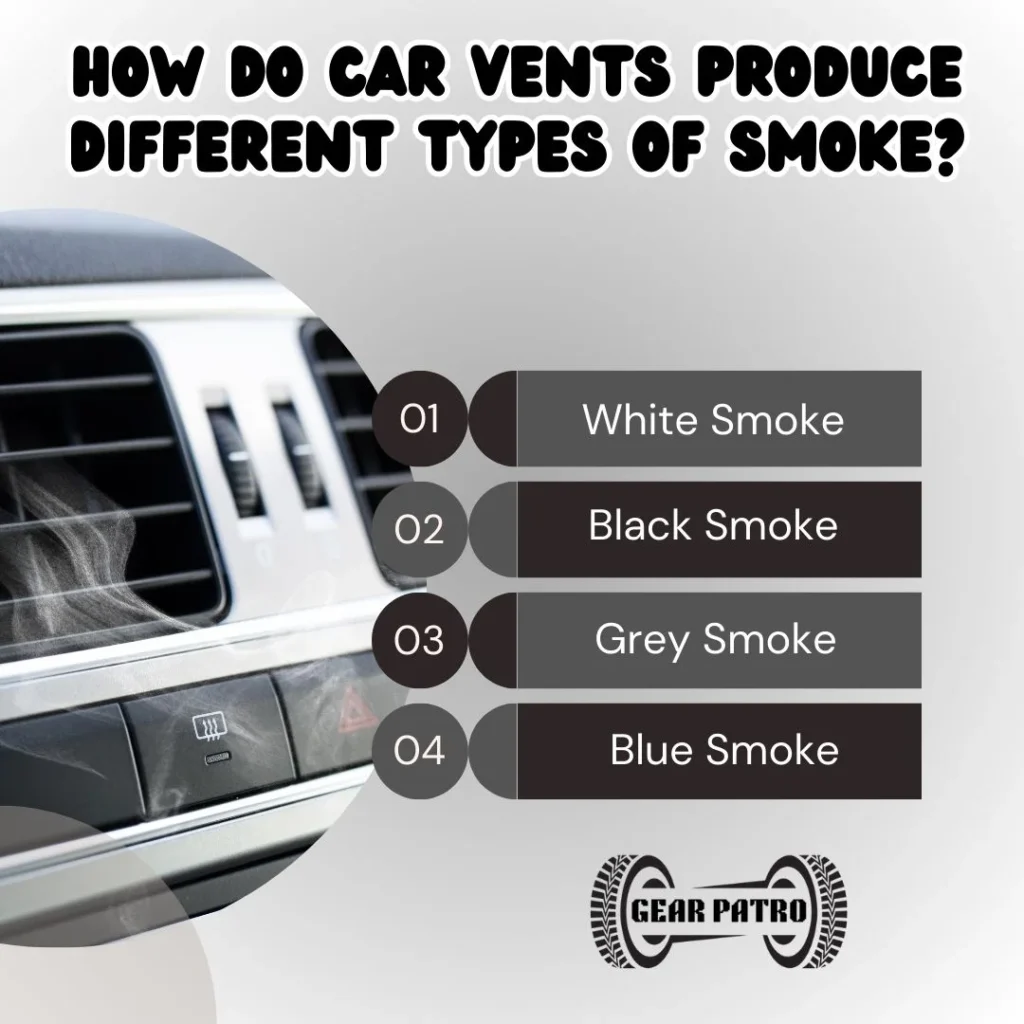When you turn on your car’s air conditioner and heater core, you should trust that you are getting clean, fresh air. There’s nothing more disturbing than seeing white smoke coming from your vents.
You should turn off the air conditioning and vent fans in your car first. By rolling down the windows, you can breathe clean air. It is important to pull over as soon as possible if you see white smoke escaping from your vents.

The most likely cause of this issue is either a leaky coolant or a frozen air conditioning system. A leak caused by an ongoing heater would have a sweet smell despite the fact that the leak is caused by an ongoing heater. Besides these possibilities, there are others.
Understanding how your AC and heat vents work will help you figure out why white smoke is coming from them. I hope we can come up with a cheap solution that won’t break the bank.
Why White Smoke Is Coming Out Of Your Car AC Vent?
Your interior climate control may be set to a high temperature, as well as the weather at that time, if you see white smoke coming from your vents. There will also be an odor of smoke or steam. If you set recirculated air for the vents, make sure to note whether fresh air was used. There are several main culprits for such a problem, including:
Leaking Coolant In The Heater Core
Having your climate control set to heat can cause white smoke to come out of your car’s vents for a variety of reasons. One of the most common causes is coolant leaks in the heater core. When the air conditioning is on, this wouldn’t happen unless you quickly switch from heat to air conditioning.
Antifreeze engine coolant steam also gives off a sweet smell due to its composition. You might want to check your engine coolant reservoir if it seems low and/or if it runs hotter than usual.
Vents With A Mouse Nest
A mouse nest in the ventilation system can cause your car’s vents to emit white smoke or dust. When you store your car for a while or start your air conditioner in the spring, you’re more likely to experience this problem.
It is the mice that build their nests inside your dash in order to stay warm and raise their young. After a while, the weather probably got nicer and it moved on. Upon switching on the AC for the first time, dust and other particulates are blown out. In the puff of air, you may smell stale urine or fish. Mouse nest debris may also interfere with the blower fan and cause a ticking or buzzing noise.
There might be a mouse nest on fire if you smell burnt leaves or hair and the odor is strong. By chewing on wires, mice can cause shorts or burn out blower fans, which will ignite mouse nests.
Lines Of The Air Conditioner Are Frozen
After a long period of running your car’s air conditioner on high with the air recirculating, your AC lines may be frozen up.
Sometimes the evaporator dryer or refrigerant lines behind the dash leak. The system requires a mechanic to be repaired and recharged.
A car’s frozen AC lines and/or evaporator can cost between $250 and $500 to repair or replace.
Serpentine Belt Pulley Fault
In your engine, serpentine belts drive revolving pulleys like those for the water pump, air conditioner compressor, and alternator. A serpentine belt can skid over a damaged or misaligned pulley, causing friction that causes smoke.
If your air conditioner is set to fresh air instead of recirculated air, this belt smoke could easily fill the interior of your car. If the AC compressor pulley is malfunctioning, your car’s air conditioning performance will be affected instantly.
The engine bay could also be responsible for the smoke if your climate controls are set to recirculate the air. Take a look at the engine bay after the car has been running for a while. It should only take a few seconds to detect a malfunctioning pulley.
A Shorted Electrical Wire
Electric wire shorts and burned-out motors often cause little puffs of smoke to fill your car’s vents. If white smoke appears during such a scenario, it might smell like melting plastic or burning hair.
When an electrical motor burns out or shorts out, smoke is usually produced for a short time. In this process, a fuse burns out, which prevents the shorting wires from causing fire.
You can find the electrical diagram for your fuse in the owner’s manual or repair manual of your make and model.
You might be able to determine where the short is by using this information. Changing the fuse and turning the AC vents back on may cause them to burn out again. Until the air conditioning is repaired, you should remove the fuse and leave the car’s air conditioning off.
If it’s the blower motor that’s failed, replacing the fuse will restore power. Your fan may feel weak or even die right away if you notice it is weak. When the glove box is opened, the blower fan can sometimes be inspected visibly. Newer vehicles have a closer blower fan to the heater core, so this is less likely to happen.
Clutch Burns Out
Manual transmission clutches can burn out and cause smoke to enter your dash vents. Your ventilation system should only circulate fresh air, not recirculated air, to prevent this.
Manual transmission clutches will emit small puffs of opaque white smoke, which are drawn into your car when therinding noises are heard. Burnt-out clutches are most likely to produce smoke when starting from a stop into first, which is when smoke is most likely to appear.
Dripping AC Condensation On Exhaust Manifold
As condensation drips from compressors or condensers, long-running air conditioners can drip water onto hot components like exhaust manifolds or radiators. It is possible for a little puff of steam to enter your home depending on whether your vent system is set to fresh air.
Smoke Coming Out Of Car Vents Solutions

Coolant Leak In The Heater Core
Just as you might use sealant additives to seal a minor leak in your head gasket, you can temporarily seal a minor leak in your heater core with sealant additives. It is necessary to drain the current engine coolant. The engine should be run for 10 to 15 minutes after the sealant has been applied. Water and sealant must be drained from the engine coolant before fresh antifreeze can be added.
The sealant additive may not be able to patch a serious leak in the heater core lines. It might work for a while, but it’s only going to last for around three to six months at most. In this case, you will need to have a mechanic repair or replace the heater core lines.
A heater core problem typically requires a lot of labor, as it often needs to be disassembled to be repaired. Mechanics must determine whether it is a leak in the lines or a damaged core after assessing the situation.
In addition to repairing the leak, an auto mechanic may need to replace the heater core, which may cost $250 to $700.
Nest Of Mice In Your Vents
If you’re extremely lucky, you might see a mouse nest in the vent. Using a drain snake or drain hair removal tool is an effective way to remove it. It is usually only possible to get a few bits from the nest before contacting a mechanic.
An AC technician can remove mouse nests from your vents for $75 to $250.
Serpentine Belt Pulley Failed
If a bad pulley causes the serpentine belt to smoke, it is usually necessary to replace both the pulley and serpentine belt. Pulleys need to be removed and replaced by a mechanic, but serpentine belts can be replaced by you.
Both the damaged serpentine belt and the bad pulley will cost you between $175 and $450 to replace.
Shorted Electrical Wire
In most modern cars, the wiring is encased in conduits or wiring looms, making it difficult for DIY mechanics to reach it. Since the burnt out wires are likely deep within the dashboard, only a mechanic can reach them.
If you discover that it is the blower fan, and it can be accessed without taking too much of the dash apart, you may be able to replace it yourself. If it fails to function, a mechanic will need to replace it, as well as resolve any other wiring issues.
The cost of fixing shorted-out dash wires and/or replacing a faulty blower fan ranges between $150 and $450. Depending on the difficulty, the blower fan and wires may be accessible.
Clutch Burns Out
Burned clutches need to be repaired by a mechanic, and severe damage may require a transmission specialist. Along with the clutch itself, other related components, such as slave cylinders, will also require maintenance.
In the event that the clutch burns out, it may need to be replaced, which will cost between $325 and $500.
Steam From Condensation
By switching over the recirculated air, you can stop steam and smoke from escaping from the engine bay. The better the air conditioner’s performance, the less strain it will put on the system and the less condensation it will produce.
How Do Car Vents Produce Different Types Of Smoke?
Smoke can come out of your car vents in a variety of forms depending on the circumstances. A smoke’s color, smell, and impact will vary greatly based on the condition of your car and the cause of the smoke.

Below is a list of all the types of car smoke you should be aware of.
White Smoke
As the first kind of smoke to emerge from your car vents, it is usually white smoke. Unlike smoke caused by faulty car components, this smoke has no odor and is hard to detect at first. With the passing of time, the car space begins to fill up.
Black Smoke
Smoke like this comes from something burning inside the car machinery, and it is among the most harmful car fumes. To prevent further damage, you must act immediately when you notice black smoke coming from your car vents.
Grey Smoke
Black smoke is less toxic than white smoke and is easier to detect than white smoke.
Blue Smoke
Oil leaks seeping into the hot part of the engine should emit blue smoke from your car’s vents. This issue needs to be addressed urgently.
3.0 Duramax Problems Explained
Service Theft Deterrent System Reasons And Solution
Where Are The Chevy Truck Ground Locations?
Anti Theft System Car Won’t Start: Clever Tricks to Solve!
Frequently Asked Questions
Why does white smoke appear in vents when humidity changes rapidly?
When the weather changes rapidly and humidity is high, white water vapor can sometimes escape your dash vents. Summer thunderstorms occur when strong fronts force out humid weather systems by pushing powerful thunderstorms in during cold fronts. As a result of the rapid temperature change, your front windshield may fog up for a few moments.
Is It Safe to Drive With Smoke Coming from Car Vents?
In case your car vents are emitting smoke, it is not recommended to drive. Regardless of the color of the smoke, pull over and figure out the problem before driving further.
As a result of the immense health hazards associated with this smoke, you can also die from it. If you don’t want your car to burn to ashes, don’t drive with smoke coming from your vents.
Can the smoke coming from the AC vents be fixed for how much?
Depending on the type and source of smoke, there are many variations. Smoke that is white or gray can even be fixed for free if your vehicle isn’t experiencing serious problems.
Some car damage or electrical problems may require you to pay between $600 and $1000 to remove smoke from your vents.
Is fresh air used in a car’s air conditioner or is it recirculated?
Air may be recirculated or fresh air can be used in the HVAC system depending on the vehicle. When your system is set to fresh air, the vents in the cab can let smoke into the cab.
Despite the fact that recirculated air is the best for air conditioning, many automakers have their air conditioners switch automatically to recirculated air when the AC is activated. You might even experience this if your car’s controls are set to MAX AC. Smoke and vapor can be eliminated from the engine bay by recirculating air from your HVAC system.
Conclusion
When white smoke or steam emerges from your vents, it’s often due to a leak in the coolant lines. This is especially likely to happen when you smell a sweet aroma coming from the hot antifreeze. In this case, it is usually necessary to repair the heater core.
If your interior climate control is set to fresh air, smoke may also be coming from the engine bay. Some things to watch out for are a burning clutch, leaking exhaust manifolds, or slipping serpentine belts. An engine bay professional mechanic needs to address all the other causes of smoke and steam, including drips on the manifold.
If the white smoke is recirculated, it is likely caused by something in the dashboard or cab. The two main concerns here are short-circuited wires and/or a burned-out blower fan. Fuse blowing is a common occurrence, and you may be able to trace the electrical failure back to the fuse.
Mechanics will likely have to fix the wiring short if it is so deep in the dash. You might be able to replace the blower fan yourself, but it’s more likely that a mechanic will need to do it. When you put in a new fuse before you know more, you risk a serious electrical fire in your dashboard!
